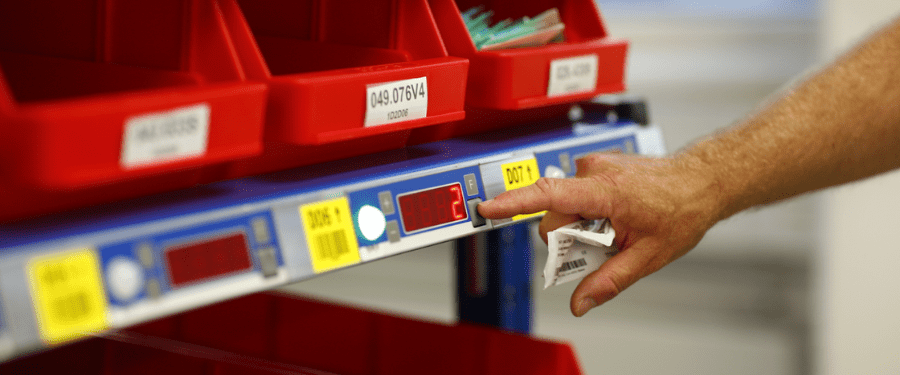Voice picking or pick to light: which is best for your business?

-min.png?width=900&name=Untitled%20design%20(2)-min.png)
We’ve worked with several companies who progressed through the stages of pick technology evolution, from paper to RF, and seen huge productivity and accuracy improvements. One of the hottest topics in these discussions is around "Which is better, Pick To Light or Pick To Voice?"
The answer to which picking system is better for your business depends on many factors such as the number of pick faces, number of pickers and amount of travel between picks.
There are also some other considerations, such as:
- the amount of re-slotting done
- the client's tolerance for errors
- desire for common technologies
- internal IT capability
- cost of ownership
- return on investment (ROI)
There are, however, a few general guidelines that help to point us in one direction or another when evaluating whether PTL, PTV or something else is the best solution for a picking operation.
Pick To Light vs. Pick To Voice
When comparing Pick To Light (PTL) vs. Pick To Voice (PTV), it’s important to consider your warehouse environment. Each system has its merits - just like different cars are better suited to different terrains. You wouldn’t take your flashy Mercedes out on a 4X4 track.
As a rule of thumb, PTV is better suited for high volumes of SKUs in large warehouses as it’s more cost effective. This is because PTL modules are installed at the physical pick locations. It can therefore be an extremely costly exercise to place large quantities of these over an extensive area. Additionally, if you regularly re-configure your pick locations, voice technology will offer you greater flexibility in your warehouse.
On the other hand, PTL is excellent for high speed picking in warehouses with a lower SKU count or a dense picking environment. It’s also often a better choice for zoned picking operations. The more pickers you have, the more cost effective PTL becomes. This is because the cost per light module decreases in line with the number of pickers.
In order to get to the bottom of this issue, it’s best to understand how the two methods differ.
How does PTV work?
With PTV , pickers wear headsets with microphones. A software system with a synthetic voice directs the picker to the pick location and the picker communicates verbally back to the software system, citing the check digits that appear on a label at the pick location. The system then instructs the picker on the quantity to be picked and conveys any further instructions the picker needs to complete the task.
How does PTL work?
With PTL (pick to light), light displays are typically installed in shelving units, case flow racks and storage racks at every fixed pick location. The display units light up, one at a time, to show pickers which order line to pick. Apart from identifying the pick location, the light unit also displays the quantity to be picked and the tote or carton that the product has to be placed into. The picker typically confirms the pick task by pushing a button on the light display. When no further lights are illuminated, the picker knows that the order is complete.
Cost and flexibility
Since PTL is a more complex technology, the initial start-up investment and cost layout can be significantly higher than it would be for PTV. PTL modules are usually physically placed at fixed locations and would also cost significantly more when many of them are deployed over a large area.
If the pick locations are constantly being reconfigured, voice technology will then probably be a better fit. This is because it’s more flexible - with reconfiguration only requiring changes to labelling, storage media and WMS changes. Reconfiguration of a PTL module, on the other hand, could require further changes to be made to the PTL software, to the light displays, the communications backbone, the physical storage media, as well as changes to the WMS.
Accuracy comparisons
Pickers using PTV technology are less prone to errors than those using PTL. A voice picking operation can expect an error rate of 0.2 to two errors per 1000 picks (translating to 99.8 – 99.98% accuracy). PTL operations, on the other hand, make about three to five errors per 1000 picks (translating to 99.5 – 99.7% accuracy).
Those numbers seem counterintuitive. One would imagine that a picker who’s told where to go and what quantity to pick would be more prone to error than a PTL operator who sees the locations and the quantity needed to be picked lit up. However, as a cost saving method, some PTL installations simply use a light at the pick location but display the quantity to pick on a bay display situated elsewhere.
Although those lights that don’t have integrated displays are less expensive, warehouses or distribution centres that have installed them pay the price in the long run in terms of accuracy – or lack thereof.
Productivity comparisons
Which of the two order picking technologies allows your warehouse or distribution centre to be more productive?
Pick to light order rates generally run between 110 and 350 lines per hour, with some pickers able to pick up to 400 lines per hour. It sounds impressive, but productivity can be adversely affected when the picker has to pick and pack concurrently. Time’s lost while trying to pack the product into the shipping carton. Even more so when the picker is working on more than two cartons or totes at a time, adding up to more than two entities per pick task.
Pick to voice, in the same applications, can run 300 lines per man-hour or less. It is less than PTL, because in a PTL environment, the picker has the advantage of being able to “look ahead” and plan their pick movements accordingly.
Maturing Technologies
Although voice picking is a newer technology, with voice directed systems having been in use in industrial applications since the 1980's – while PTL has been in use in the U.S. since the 1970’s – both are considered mature. There’s an increasing amount of hardware and software choices available for both types of systems. More uses are found for the technologies, thereby increasing the value to the operations who adopt either system.
Putting PTL and PTV to work in the real world
So, which one do major corporations prefer? E-commerce giant Amazon reportedly uses PTL systems in its fast-moving and complex warehouses. Amazon has to quickly supply customers with exactly what those customers want, all while optimising the company’s revenue and reducing costs. Since commands given over the voice-directed systems have to first be interpreted by the picker before he/she can perform the task, it can be slower than light-directed systems. While some PTV systems offer companies the ability to operate the system by using the different languages spoken by their warehouse staff, light-directed systems have no issues with language barriers or comprehension, since only numbers are displayed. A PTL system also allows the company to employ temporary seasonal workers during busy seasons with only limited training requirements.
The fourth largest pizza delivery restaurant chain in the U.S., Papa John’s replaced its manual picking process with voice-directed picking processes at its network of dough manufacturing and distribution centres in 2006. This move improved the accuracy and efficiency of the picking operations across all the company’s distribution centres. The voice system was especially useful in the freezer, where writing information by hand was difficult.
The question remains: which should you choose, PTL or PTV?
Most warehouses or distribution centres only start to consider adopting PTL or PTV when they’ve already reached “best in class” pick rate metrics and they are looking for ways to further increase productivity and accuracy.
The best way to determine which of the two technologies to choose, is to evaluate the pros and cons of each option as well as to consult with professionals to find out which one will be the best for your operation. Having that conversation before making your choice will be worth it, since you will possibly have to live with the system you end up choosing for the next five or more years.
Get practical about your WMS Implementation with our handy checklists, and ensure that you've thought of everything before you kick off a new WMS design and implementation:
TAGS
- WMS (51)
- Warehouse Best Practice (46)
- Implementing a WMS (29)
- Managing your warehouse (19)
- Omni Channel (18)
- eCommerce (18)
- Blog (16)
- Supply Chain Best Practice (16)
- Mid-Level (8)
- Customer Journey (7)
- Warehouse optimisation (7)
- General Tips (5)
- Industry General (5)
- Information (5)
- managing your Supply Chain (5)
- saudi arabia (5)
- Trends (4)
- smart warehouse (4)
- 3PL (3)
- News (3)
- ERP (2)
- Entry-level (2)
- ROI (2)
- Case Study (1)
- OMS (1)
- Picking (1)
- Press Release (1)
- Solution-Specific (1)
- Transport Management System (1)
Take A Look At The Results Of A Successful WMS Implementation.
See how Tarsus Distribution, in collaboration with SCJ boost overall efficiency by 60%





